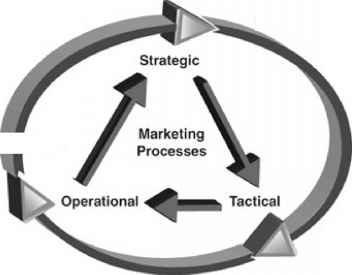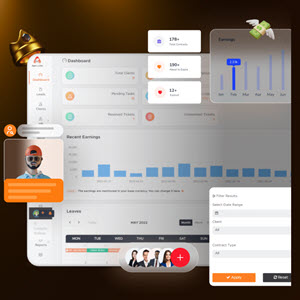Future Trends in Six Sigma and Marketing Processes
[View full size image]
Posl-Launch Product Line Managemens and Sales
Inbound Marketing
Outbound Marketing
Posl-Launch Product Line Managemens and Sales
Outbound Marketing

Inbound Marketing
Product Portfolio Renewal
Product Commercialization
Product Portfolio Renewal
Product Commercialization
The contribution that "science" provides to marketing is gaining momentum with the advent of improved technology (Customer Relationship Management [CRM] systems, sales automation and work-flow tools, Internet/web/wireless/digital), increased pace of change, and a "flattening" of the world (globalization). The combination of "art" and "science" will continue to be important to overall success, but marketing requires faster access to relevant data to help you make better fact-based decisions. Marketing would benefit from a universal language, structure, and common tool set to better collaborate and innovate not only internally with its colleagues, but also with customers, value chain partners, and "coopetition." ("Coopetition" is the concept wherein competitors join forces in a limited capacity and act as partners to deliver a product or service, often to respond to another third party. This is common in fast-changing industries such as high technology.) The global marketplace will demand better leadership, improved relationships, and more creativity from top firms.
As Lean and Six Sigma mature, we forecast that their impact on business will expand and deepen. Both Lean and Six Sigma can help marketing create a competitive advantage with better information and more proactive management of go-to-market resources and processes and to drive and sustain growth. As a result, we predict that the following business trends will unfold:
• The formation of marketing centers of excellence to promote continuous improvement and the standardization and "rightsizing" of marketing tools, tasks, and deliverables.
• Enriched and expanded understanding, on the part of marketing, as to the best practices and methods of executing tools, tasks, and deliverable work flows. It takes time to do things right. As executives who want sustained growth become aligned with the proper structuring (rightsizing) of marketing work, the efficiency and performance of marketing teams will become far more predictable. Critical marketing functions executed with rigor and discipline produce deliverables with greater certainty.
• Differentiated marketing work flows will be categorized as strategic, tactical, and operational processes similar to those in R&D, product design, and production/service support engineering organizations. The jack-of-all-trades approach will migrate toward more marketing specialization to improve execution excellence that assimilates analytical marketing tools into its best practices.
• Six Sigma concepts will serve as the foundation for a universal marketing language. A greater investment will be made in applying its concepts and implementing specific tool-enabled marketing activities to produce more predictable, successful growth.
• Increased focus on the fundamental marketing variables critical to customer behavioral dynamics (Y = f(X)). Better definition of what underwrites a real cause-and-effect relationship, and how to measure and control critical marketing parameters that prevent problems. Measuring variables that signal impending failure rather than measuring failures and reacting to them. Marketing teams will stop measuring what is easy and convenient if it is not fundamental to true cause-and-effect relationships within and across marketing variables.
• A shift from DMAIC Six Sigma for problem-solving and cost control to a phase-gate approach aimed at problem prevention and investment in properly designed marketing work flows to enable growth projects.
• Growing accountability of marketing professionals to drive growth and, with demonstrated success, a rebalancing of marketing and technical/engineering personnel in an enterprise so that marketing can better and more completely perform the expected tasks. This will reflect the designed balance between an enterprise's marketing and technical innovation strategy.
• Improved collaboration between technical and marketing professionals across strategic, tactical, and operational environments. "That's not my job" attitudes will dissipate and be replaced with better cross-functional teamwork. This will be particularly true in all areas where customer needs, complaints, and sensitivities require translation into technical requirements to avoid future problems by proactive knowledge sharing.
• Transformed thinking to a platform and modular design will help marketing design and monitor the flow of product and service offerings in a balanced portfolio deployment context. An elegant, designed flow of product (and service) families and preplanned line extensions will make it easier to align limited corporate resources to evolving market and competitive dynamics and meet on-time launch demands. This modular approach also reduces the intensity of risk for a single launch and spreads risk across multiple launches.
• Elevated use of an integrated set of scorecards to measure marketing risk to improve decisionmaking. Checklists must give way to more discriminating scorecards at the marketing tool, task, and deliverable level.
The benefits of applying Lean and Six Sigma to marketing make it worth the investment. Using the Lean and Six Sigma approaches gives decision-makers better information and helps drive uncertainty out of marketing. Companies can better align their product ideas with solid market opportunities and better balance and manage their offerings portfolio by using Lean and Six Sigma to significantly increase the probability of marketplace success. These approaches offer a common structure and language that will facilitate communication throughout the tactical product development and commercialization process between marketing and engineering. Operationally, marketers using Six Sigma become more proactive in managing value-chain resources and go-to-market processes. Scott Fuson, corporate executive director of marketing, sales, and customer service at Dow Corning, gave a compelling testimonial for marketing to embrace Six Sigma. In a recent Journal of Product Innovation article, Fuson stated that "The big difference is that before, someone might do something really terrific, but then change jobs or position and the great work would fade away. Six Sigma makes those improvements sustainable; they don't go away . . . they're built into the process."
We hope you have a better understanding of how to apply Six Sigma and Lean to marketing. It will be a while before Six Sigma for Growth has the same impact on marketing as it has on the design community (using Design for Six Sigma [DFSS]). Your leadership and willingness to take the hard fork in the road will make the difference as you seek sustained profitable growth for your firm.
4 PREY
NEXT t
Was this article helpful?


